Arthroscopy, also called key-hole joint surgery is one of the latest and advanced treatment modalities to treat joint injuries. In this procedure, using fine telescopes, the inside of the joint is visualized and surgical procedures are carried out using specialized instruments. Arthroscopic procedures for treating knee ligament tears and meniscus tears are the gold standard of treatment. In addition shoulder problems like dislocations, rotator cuff tears are treated arthroscopically. Arthroscopy has a significant role in the management of an injured athlete and allows the athlete to return to the previous level of activity.
BAJAJ SPECIALIST CLINICS is one of the Best Centres in the NCR offering facilities of Minimally Invasive Orthopaedic Surgery dealing with Joint Replacement Surgery, Joint Surgery, Arthroscopic Surgery, Sports Surgery and Trauma Surgery using smaller incisions. These procedures are performed at BAJAJ SPECIALIST CLINICS as Short stay with the latest Equipment and world class cutting edge technology backed up with a Fully equipped Sports Physiotherapy Centre for Management of Sports Injuries and their Rehabilitation along with a Comprehensive Post Joint Replacement Rehabilitation Programme.
Facilities at the centre include Radiology, splinting, braces and all modern techniques of Physiotherapy with a Fully equipped Sports Physiotherapy Centre for Management of Sports Injuries and their Rehabilitation along with a Comprehensive Post Joint Replacement Rehabilitation Programme.
The Centre is headed by Dr Pushpinder Singh Bajaj MS (ORTH), DNB (ORTH), FIAS(UK), MSc-ORTH(UK), AO Fellowship(Germany), Dipl. Sports Medicine(UK), Arthroscopy & Joint Replacement Fellowship(Australia ) who is an eminent figure with over 20 years of Experience in the field of Joint Replacement Surgery & Arthroscopic Surgery ( KEY HOLE SURGERY ) of the Knee & the Shoulder nationally & internationally.
- Having trained & worked abroad in UK, Australia, Germany & USA for several years in the field of Joint Replacement Surgery, Sports Medicine & Arthroscopic Surgery, Dr Bajaj has been in practice in Delhi for the last 16 years.
- He is credited with the treatment of various eminent personalities including top Indian sports players CRICKET : Virender Sehwag, Gautam gambhir, SHOOTING : Rajyavardhan Rathore, TENNIS : Mahesh Bhupathi, GOLF : Jeev Milkha Singh, Top Diplomats including including the Ambassadors / High Commissioners of UK, USA, Canada, Australia, etc, Various MP and MLAs including Shri Rajyavardhan Rathore ( MOS I & B ), Shri Manish Tewari ( ex I & B ), Shri S M Krishna ( ex Ext Affairs ).
-
Field of expertise is in Advanced Joint Replacement procedures including
- High Flexion knee replacement
- Minimally Invasive Knee Replacement
- Custom fit Knee Replacement
- Total Hip & Total Shoulder Replacement Surgery
- He has also various articles in the field of Minimally Invasive Orthopaedic Surgery published in the leading newspapers along with the experience of conducting workshops and providing training to Doctors in the field of Joint Replacement & Arthroscopic surgery.
- Beside being invited faculty to various national & International conferences for giving guest lectures & performing Live surgeries, Dr Pushpinder Bajaj is the President of ISKSAA ( International Society for Knowledge for Surgeons on Arthroscopy & Arthroplasty ) which is an International association dedicated for continued Orthopaedic education in the fields of Arthroscopic Surgery & Joint Replacement Surgery ( www.isksaa.com )
- He has already operated in over 50 cities of North India.
-
He has performed over 3000 Joint Replacement Surgeries till now including
- Hip Resurfacing procedures
- High Flexion Knees, Minimally Invasive Knee Replacements, Unicompartment Knee Replacements
- Shoulder Replacement Surgery.
-
He has performed over 10000 Arthroscopic Procedures till now including.
- Arthroscopic ACL / PCL knee reconstructions
- Arthroscopic Bankart’s repair for Dislocated Shoulders
- Rotator Cuff repair in the shoulder
The Clinic offers Competitive treatment packages for various surgical procedures performed in State of the art Operation Theatres complimented with top of the line Equipment & implants for Arthroscopic Surgery of all joints including knee & shoulder
- Arthroscopy of the Knee
- Arthroscopic ACL / PCL Knee Ligament Reconstruction
- Meniscal Repair of the Knee
- Mosaicplasty for cartilage Defects
- Arthroscopy of the Shoulder
- Impingement / frozen shoulder
- Arthroscopic Bankart’s Repair for recurrent dislocations shoulder
- Arthroscopic Rotator cuff repair of shoulder .
- Ankle / Wrist / Elbow / Hip Arthroscopy
All these procedures are backed up with world class physiotherapy & rehabilitation facilities at reasonable charges.
If you have persistent pain, catching, or swelling in your knee, a procedure known as arthroscopy may help relieve these problems.
Arthroscopy allows us to diagnose and treat knee disorders by providing a clear view of the inside of the knee with small incisionss, using a pencil-sized instrument called an arthroscope. The scope allows transmission of an image of your knee through a small camera to a television monitor. The image allows us to thoroughly examine the interior of the knee and determine the source of the problem. During the procedure, we also can insert surgical instruments through other small incisions in your knee to remove or repair damaged tissues.
With improvements of arthroscopes and higher resolution cameras, the procedure has become highly effective for both the accurate diagnosis and proper treatment of knee problems.
The knee is the largest joint in the body, and one of the most easily injured. It is made up of the lower end of the thigh bone (femur), the upper end of the shin bone (tibia), and the knee cap (patella), which slides in a groove on the end of the femur.
Four bands of tissue-the anterior and posterior cruciate ligaments and the medial and lateral collateral ligaments-connect the femur and the tibia and provide joint stability. Strong thigh muscles give the knee strength and mobility.

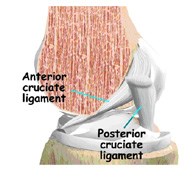
The surfaces where the femur, tibia, and patella touch are covered with articular cartilage. Articular cartilage is a smooth substance that cushions the bones and enables them to glide freely. Semicircular rings of tough fibrous cartilage tissue, called the lateral and medial menisci, act as shock absorbers and stabilizers.
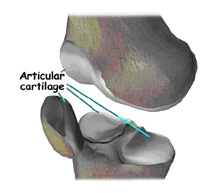
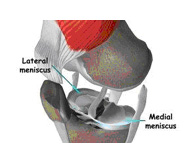
The bones of the knee are surrounded by a thin, smooth tissue capsule lined by a thin synovial membrane. The synovium releases a special fluid that lubricates the knee, reducing friction to nearly zero in a healthy knee.
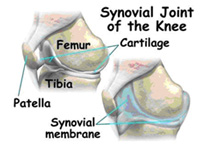
Knee Problems Normally, all parts of the knee work together in harmony. Sports, work injuries, arthritis, or weakening of the tissues with age can cause wear and inflammation, resulting in pain and diminished knee function. Arthroscopy can be used to diagnose and treat many of these problems:

Problems in the knee joint that usually can be seen with an arthroscope.
- Torn meniscal cartilage.
- Loose fragments of bone or cartilage.
- Damaged joint surfaces or softening of the articular cartilage, known as chondromalacia.
- Inflammation of the synovial membrane, such as rheumatoid or gouty (crystalline arthropathy) arthritis.
- Abnormal alignment or instability of the kneecap.
- Torn ligaments, including the anterior and posterior cruciate ligaments.
By providing a clear picture of the knee, arthroscopy can also help us decide whether other types of reconstructive surgery would be beneficial.
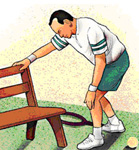



You need to be evaluated by us to determine whether you could benefit from arthroscopy.
Signs that you may be a candidate for this procedure include swelling, persistent pain, catching, giving way, and loss of confidence in your knee. When other treatments, such as the regular use of medications, knee supports, and physical therapy, have provided minimal or no improvement, you may benefit from arthroscopy.
Most arthroscopies are performed on patients between 20 and 60 years of age. Patients younger than 10 years of age and older than 80 years of age have benefited from the procedure as well.
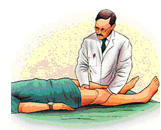
The orthopaedic knee evaluation usually consists of a medical history, a physical examination, and X-rays.
During the medical history, we will gather information about your general health and will ask you about your symptoms.
A physical examination will be done to assess the motion and stability and muscle strength of the knee as well as the overall alignment of the leg.
X-rays will be done to evaluate the bones of the knee. We may also arrange for you to undergo magnetic resonance imaging (MRI) to provide more information about the soft tissues of your knee. An MRI uses magnetic sound waves to create images. They are not X-rays. Blood tests may be obtained to determine if you have arthritis.
We will review the results of your evaluation with you and discuss the best methods to further diagnose your knee problem. Other diagnostic tests may be indicated, such as magnetic resonance imaging (MRI).
We will explain the potential risks and complications of knee arthroscopy, including those related to the surgery itself and those that can occur after your surgery.
If you decide to have arthroscopy, you may be asked to have a complete medical examination before surgery. This will assess your health and rule out any conditions that could interfere with your surgery.
Before surgery, tell us about any medications or supplements that you are taking. You will be informed which medications you should stop taking before surgery.
Tests, such as blood samples or a cardiogram, may be ordered by us to help plan your procedure.
Almost all arthroscopic knee surgery is done on an outpatient basis for healthy patients. Usually, you will be asked to arrive at the hospital an hour or two prior to your surgery. Do not eat or drink anything after midnight the night before your surgery.
After arrival, you will be evaluated by a member of the anesthesia team. Arthroscopy can be performed under local, regional, or general anesthesia. Local anesthesia numbs your knee, regional anesthesia numbs you below your waist, and general anesthesia puts you to sleep. The anesthesiologist will help you determine which would be the best for you.
If you have local or regional anesthesia, you may be able to watch the procedure on a monitor, if you wish.
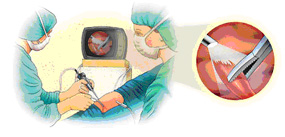
We will make a few small incisions in your knee. A sterile solution will be used to fill the knee joint and rinse away any cloudy fluid, providing a clear view of your knee.
We will then insert the arthroscope to properly diagnose your problem, using the image projected on a monitor to guide the arthroscope. If surgical treatment is needed, we can use a variety of small surgical instruments (e.g., scissors, clamps, motorized shavers, or lasers) through another small incision.
Common treatments with knee arthroscopy include:
- Removal or repair of torn meniscal cartilage.
- Reconstruction of a torn cruciate ligament.
- Trimming of torn pieces of articular cartilage.
- Removal of loose fragments of bone or cartilage.
- Removal of inflamed synovial tissue.
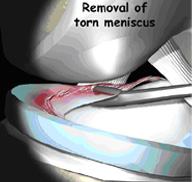

At the conclusion of your surgery, we will close your incisions with a suture and cover them with a bandage.
You will be moved to the recovery room / daycare room . Usually, you will be ready to go home in four to six hours. You should have someone with you to drive you home.
Recovery from knee arthroscopy is much faster than recovery from traditional open knee surgery. Still, it is important to follow our instructions carefully after you return home. You should ask someone to check on you that evening.
Keep your leg elevated as much as possible for the first few days after surgery. Apply ice to relieve swelling and pain.
You will leave the hospital with a dressing covering your knee. It will be removed after 2 days . You may shower, but should avoid directing water at the incisions. Do not soak in a tub. Keep your incisions clean and dry.
We will see you in the office a few days after surgery to check your progress, review the surgical findings, and begin your postoperative treatment program.
After most arthroscopic surgeries, you can walk unassisted. You may be advised to use crutches, a cane, or a walker for a period of time after surgery. You can gradually put more weight on your leg as your discomfort subsides and you regain strength in your knee. You may be allowed to drive after a week.
You should exercise your knee regularly for several weeks following surgery to strengthen the muscles of your leg and knee. A physical therapist will help you with your exercise program

You will be prescribed antibiotics to help prevent an infection and pain medication to help relieve discomfort following your surgery.
Potential postoperative problems with knee arthroscopy include infection, blood clots, and an accumulation of blood in the knee. These occur infrequently and are minor and treatable.
Call us immediately if you experience any of the following:
- Fever
- Chills
- Persistent warmth or redness around the knee
- Persistent or increased pain
- Significant swelling in your knee
- Increasing pain in your calf muscle
Although arthroscopy can be used to treat many problems, you may have some activity limitations even after recovery. The outcome of your surgery will often be determined by the degree of injury or damage found in your knee. For example, if you damage your knee from jogging and the smooth articular cushion of the weightbearing portion of the knee has worn away completely, then full recovery may not be possible. You may be advised to find a low-impact alternative form of exercise.
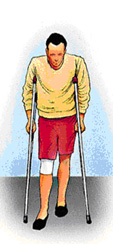
An intercollegiate or professional athlete often sustains the same injury as a weekend recreational athlete, but the potential for recovery may be improved by the over-development of knee muscles.
Physical exercise and rehabilitation will play an important role in your final outcome. A formal physical therapy program also may add something to your final result.
A return to intense physical activity should only be done under our direction.
It is reasonable to expect that by six to eight weeks you should be able to engage in most of your former physical activities as long as they do not involve significant weightbearing impact. Twisting maneuvers may have to be avoided for a longer time.
If your job involves heavy work, such as a construction laborer, you may require more time to return to your job than if you have a sedentary job.


First of its kind in Delhi. Fully equipped with Cardio/Strength Equipment (PRECOR USA), Stretchtrainer(PRECOR USA), Swiss balls, Therabands, Cryotherapy (AIRCAST USA ), Trampoline, Wobbleboard & other imported Sports Rehabilitation Equipment
- Management of Sports Injuries & Rehabilitation
- General Physical conditioning
- Fitness Assessment
- Sports Performance Enhancement Programmers especially Golf, Swimming, Field & Track events, Tennis and other Request sports.

Fully equipped with 7 private cubicles with all modern imported equipment to deal with all types of acute and chronic pain / Orthopaedic conditions
- SHORTWAVE DIATHERMY
- ULTRASONICS
- INTERFERENTIAL THERAPY
- NEUROMUSCULAR STIMULATION
- TENS
- LASER
- WAX BATH
- HYDROOCULATOR
- CRYOTHERAPY
- HOT / COLD PACK CONTRASTS
- COMP.CERVICAL & LUMBAR TRACTION
- EXERCISE MACHINES
- LOW BACHACHE
- DISC PROLAPSE
- CERVICAL SPONDYLOSIS
- PLANTER FASCITIS (HEEL PAIN)
- SPRAINED ANKLE
- FROZEN SHOULDER
- KNEE PAIN
- OSTEOARTHRITIS
- RHEUMATOID ARTHRITIS
- COCCYDYNIA
- TENNIS ELBOW
- GOLFERS ELBOW
- TORTICOLLIS
- POST TRAUMA REHABILITATION
- POSTPLASTER REMOVAL REHABILITATION
- POST SURGICAL REHABILITATION
- POST PARTUM ABDOMINAL CARE
- POST STROKE REHABILITATION
